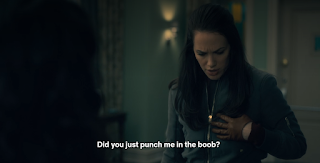Maybe I expect more, maybe I expect something different.
Case in point: after reading the reviews and surveying the general sentiment, it feels like I'm the only one who didn't enjoy Netflix's adaptation of Shirley Jackson's The Haunting of Hill House.
I wanted to like it. I was excited when I heard it was in production. I was willing to give it the benefit of the doubt even after seeing all the red flags in the trailer. Unfortunately, The Haunting of Hill House failed to hit the mark for me on all the important targets:
Adaptation. There's really no reason for this series to be tied to Shirley Jackson's novel, aside from banking on name recognition. The series suffers by comparison to Jackson's masterpiece. The elements shared between the series and the novel are neutered and listless in the former. For example, consider the fate of the "cup of stars." In Jackson's novel, the cup of stars is a powerfully written and subtle symbol found early in the book whose significance only grows in the context of the events that follow; in the show, the cup of stars is reduced to an Easter egg--a knowing nod to the audience, a name-check, a moment of cynical branding that possesses none of the original's punch.
Aesthetic. The Haunting of Hill House would have been more effective is it wasn't filmed in a style similar to that of A Series of Unfortunate Events. The house never really feels threatening or even old; it doesn't have a presence on the screen. The mold-like infection meant to symbolically relay the corruption at the heart of the story is rendered sterile and antiseptic. The supernatural moments look unreal, but not in the sense of invoking dream-like, phantasmagorical atmosphere; it's hard to suspend disbelief that the setting wasn't largely created in post-production. The make-up effects are particularly clownish; you know who the ghosts are because they have bluish or greenish faces that would be right at home in a Goosebumps adaptation.
Tone and theme. Horror as a way of exploring familial trauma is nothing new, but it can work exquisitely well. It doesn't work well in The Haunting of Hill House because the soap opera far outweighs any interesting insights into family dynamics, generational discord, or interpersonal connection. What we get instead is...well, the captioned dialog to the left speaks for itself. What's worse is that some of the family drama rings patently false; the drug addiction subplot, for example, references the relatively sanitized and banal tv version of drug addiction rather than the far more potent horrors of substance abuse in the real world. Ditto the mental health subplots.
 |
| Seriously: how tired is this imagery? |
Storytelling. Look, if you are surprised at the resolution of the bent-neck lady, you need to get out more and yet also find the time to read more. The plot is a study in obviousness and the ending is as unsatisfying as a Hang in There motivational poster.






I watched Penny Dreadful based on seeing you talk about it. I think each year was better than the one before it.
ReplyDeleteThe funny thing is, I disliked some of the individual decisions they made, but ultimately liked the effect they had on the show. I didn't particularly want to shift over to America, I didn't love the way they kept adding retroactive continuity to Vanessa's character - and yet, undeniably, the show got better and more enjoyable to watch because they did. There's probably a lesson in that, though I can't say what it is.
I'm very curious what would have happened if it kept going, especially with Jekyll and Gray.
@ Anne
ReplyDeletePenny Dreadful has some questionable elements, but I think that the overall effect it conjures from them is fantastic. (I didn't mind the American shift too much, but I'm also a sucker for "Gothic Western.") I would also have liked to see where things went in another season or so (what was the deal with Catriona, for example?) but I'm also glad it had a real conclusion before the inevitable degradation of quality.
Thus we gather around Penny Dreadful, which even an old orthodox bishop was loving the other day. While we haven't seen THoHH yet (no strong interest despite casting) it sounds like the show we like took the conventions as a vocabulary for talking about something more interesting (empire and Vanessa's immoral education) while the other one is, once again, satisfied with emulating the conventions. Penny Dreadful tinkers with its collage (and decolletage) until it expresses something drawn from outside its canon.
ReplyDeleteThis other show feels more like mature Peter Jackson (not a good thing) in spending its time representing the source within its genre . . . a haunted house has to have screaming Odd Nerdrum women in it now while the real toxic mold syndrome is completely unspeakable or even invisible. They just don't feel the horror of having to live in a place that is being poisoned in your lifetime and you can't bring yourself to run from the equity before it takes you too. There's no synthetic experience to bring to the canon. I get a real Frighteners vibe but haven't seen it so who knows.